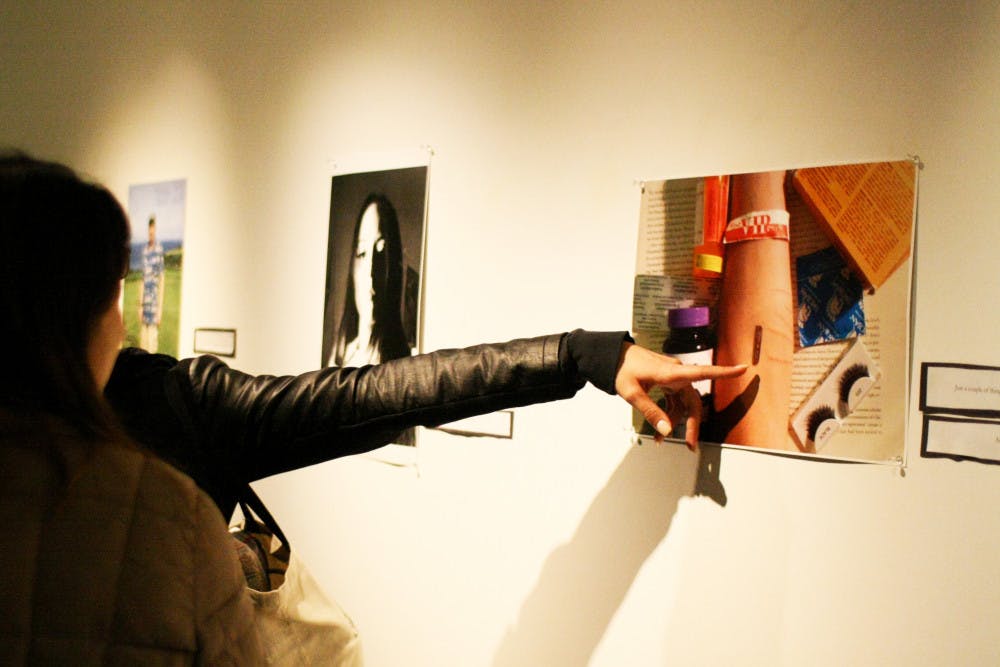#dispix is one of the four final projects for PHP 1680I: “Pathology to Power: Disability, Health and Community.” This article is the first in a series that will cover students’ attempts to increase the visibility of disability on campus.
An expectant buzz filled the Brown/RISD Hillel Social Hall as students and professors gathered at the unveiling of #dispix, a social art project and photo exhibition. #dispix features photos taken by Brown students and Providence community members with disabilities, giving them an opportunity to depict the world as they see it through a photograph.
Event coordinators asked participants to “encapsulate their disability,” and submissions varied widely, from pictures of batteries to selfies. Each photo was accompanied by a caption that described its significance.
Bruce Becker, professor of emergency medicine attending at the Alpert Medical School, originally started PHP 1680I: “Pathology to Power: Disability, Health and Community.” He now co-teaches the course with Sarah Skeels, a teaching associate in behavioral and social sciences at the School of Public Health.
Picture this
The idea for a photography exhibition came from Photovoice, a grassroots photography project that tells the stories of marginalized groups, said Gabrielle Goodrow ’16, one of the event coordinators.
The decision to let people take their own photos with their phones was deliberate, Goodrow said, noting that it gave them control over the presentation of their lives. When professional photographers are involved, there is a tendency to dehumanize disability, she said.
Emily Siegel ’16, another event coordinator, contributed a photo of her grandfather to the exhibition. She said she saw the picture as particularly significant because “people believe that disability is something they are immune to, but it happens to everyone if they live long enough.”
Morgan Demmler ’17, another coordinator of #dispix who has been diagnosed with borderline personality disorder, said the response to her photo contribution was “very accepting,” adding that Brown students’ general open-mindedness has made it easier for her to talk about her disability.
Changing course
“The course speaks to an area of great need and curiosity on the part of Brown students,” Becker said. “There is no other such course on disability studies on campus, and there never has been.”
The main objective of the course is to challenge preconceptions about disability, Becker said. “We have a whole story in our heads. You don’t have to go any further than Disney movies — the man with the amputated arm is Captain Hook, the villain. Part of the work we do in the course is to tear some of this edifice away.”
“I never went through a process to learn to talk about disability properly before,” said Libby Zorn ’16, a student in the course.
Capped at 45 students, the course has become increasingly popular in recent years, said Amy Andrews ’16, a coordinator of #dispix.
Guest speakers with disabilities present on subjects such as sexuality as they understand them, Becker said.
Most of the students enrolled in the course are pre-med, and projects and guest speakers are intended to prepare them for the social ramifications of practicing medicine, he said. “Nothing in pre-med coursework so far prepares you for the moment when you have to give someone a diagnosis,” he added.
Siegel, a pre-med student, said she perceived a disconnect between the medical and social models of disability. She said she struggled with learning to look beyond medical terminology at the beginning of the semester. “I’d be thinking, what is the mental health diagnosis I’m supposed to be looking for in this movie? Then I’d have to say, ‘Stop. It doesn’t matter,’” she said.
While the exhibition showcased a spectrum of illnesses and ages from Brown and beyond, a gender imbalance was evident. Of the 10 photos, only two were submitted by men.
“It was a self-selecting sample — people in our section reached out to people that they knew, and our section is mostly women,” Andrews said, adding that the majority of students in the class also identify as women.
Becker said the class had always been more popular among female students, despite having both male and female teachers. “I find it interesting, but I haven’t had the time to look into it. I will say that a man doesn’t take disability studies because of the ways men are raised in our culture.”
Raising awareness
Goodrow said the goal of #dispix was to increase awareness about disability on campus.
Demmler said she feels the administration is “not on the same page” as she is, noting that she found it difficult to be re-admitted to the University after taking a year off for health-related issues. “They think they’re helping us, but they are not listening to us,” she said.
Alison Rolandelli ’16, an attendee, said while Brown students “are always trying to be politically correct, we don’t always know how.” She said the event made her start to question her attitude toward disability, though she left with no hard answers.
“I would have described the event as inspiring, but seeing what one girl wrote about always being seen as brave first and never pretty, I don’t know — #dispix has been eye-opening,” Rolandelli said.
Looking ahead, the coordinators hope to see #dispix go digital. They plan on posting the pictures and captions on a website and adding submissions to their online collection, Goodrow said.





